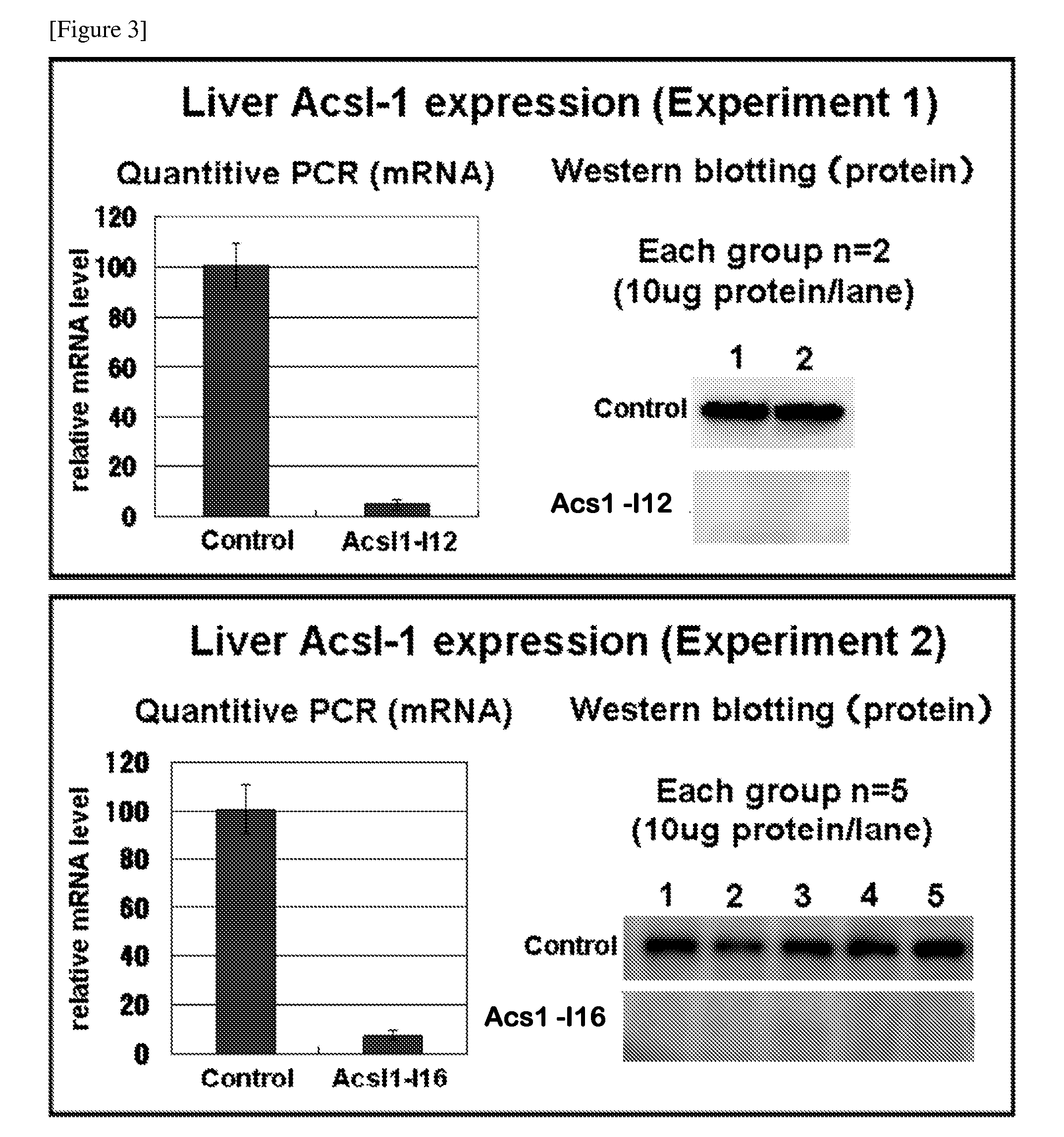Pharmaceutical composition for treating obesity or diabetes
a technology for treating obesity or diabetes, applied in the field of acsl1, can solve the problems of unexpected new findings, increase in the number of patients associated with lifestyle changes, etc., and achieve the effect of strong prevention or treatment, prevention or treatmen
- Summary
- Abstract
- Description
- Claims
- Application Information
AI Technical Summary
Benefits of technology
Problems solved by technology
Method used
Image
Examples
example 1
[0093]Design of shRNA and Preparation of Double Strand Oligo DNA
[0094]As follows, shRNA to the mouse Acsl-1 variant 3 ORF (Refseq ID XM—991228) were designed. At first, as the sense target sequence, under the condition that four bases must be thymine or adenine in seven bases of 3′ end and four consecutive thymine bases were not connected. 27 sequences to which 19 bases consecutive in the above gene were completely corresponding were selected (FIG. 1). The complementary strand to these each sense target sequence was assumed to be an anti-sense target sequence. Next, top strand oligo DNA that had a loop sequence (TTCAAGAGA or ATCAAGAGA) between the sense target sequence and the anti-sense target sequence, and that had a TTTTTT sequence which is a Pol III terminator sequence in 3′ end of the anti-sense target sequence was designed. In addition, a BamH I site in 5′ end and a Not I site in 3′ end were introduced and it was assumed a top strand oligo DNA-BN. The complementary sequence to...
example 2
Cloning of Mouse Acsl1 Gene and Construction of the Gene Expression Vector
[0095]Total RNA was treated with DNase I and collected from liver of C57BL / 6J (Japan Charles River) with RNeasy Mini Kit (QIAGEN) according to the appended manual. Following, cDNA was synthesized with SuperScriptIII First Strand Synthesis System (invitrogen) according to the appended manual. The Mouse Acsl-1 (variant 3) gene fragment inserted a Not I site in 5′ end and a Xho I site in 3′ end was obtained by PCR with the cDNA as a template DNA, Acsl-1 cloning primer (SEQ ID NO:3 and 4) and Phusion High-Fidelity DNA polymerase (FINNZYMES) under the condition that repeated 10 times the cycle: 98° C. 10 sec, 68° C. 10 sec, and 72° C. 1 min. The expression vector was produced by the ligation of the obtained fragment and pCR3.1 (invitrogen) that were treated with Not I and Xho I.
example 3
[0096]Construction of shRNA Expression Vector
[0097]pShuttle vector (Clontech) was digested with Xba I and Spe I to eliminate CMV promoter region and was inserted in human U6 promoter. It was assumed a pShuttle-U6. The shRNA expression vector was produced by inserting double strand oligo DNA made by a method in Example 1 into this pShuttle-U6 which was treated with BamH I and Not I.
PUM
 Login to View More
Login to View More Abstract
Description
Claims
Application Information
 Login to View More
Login to View More - R&D
- Intellectual Property
- Life Sciences
- Materials
- Tech Scout
- Unparalleled Data Quality
- Higher Quality Content
- 60% Fewer Hallucinations
Browse by: Latest US Patents, China's latest patents, Technical Efficacy Thesaurus, Application Domain, Technology Topic, Popular Technical Reports.
© 2025 PatSnap. All rights reserved.Legal|Privacy policy|Modern Slavery Act Transparency Statement|Sitemap|About US| Contact US: help@patsnap.com



